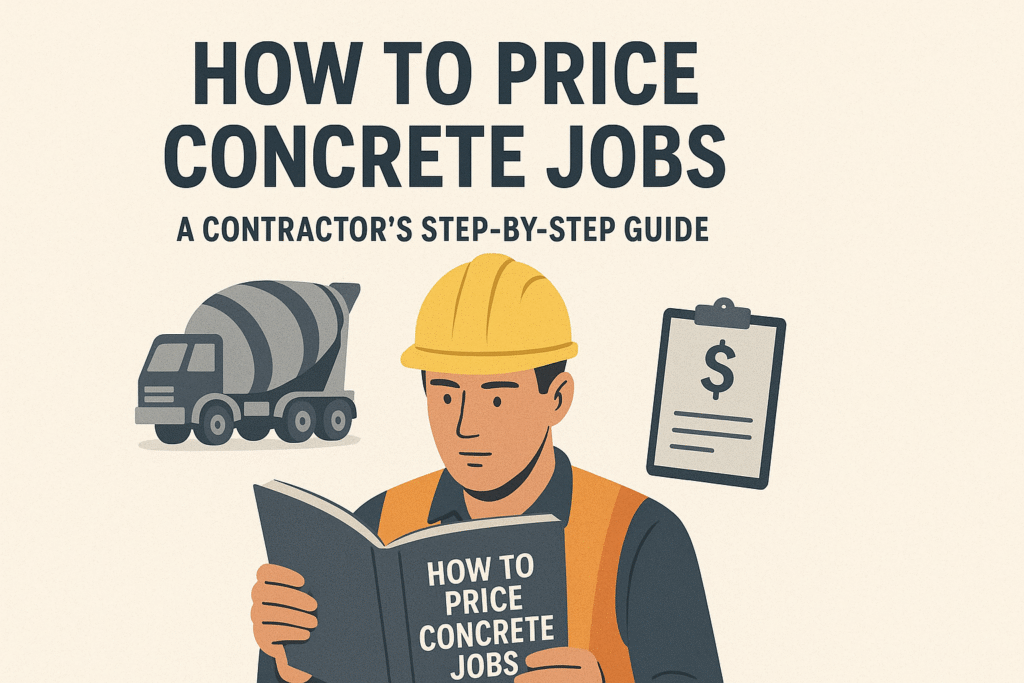Pricing a concrete job isn’t just about adding up material costs and labor hours — it’s about creating a fair, competitive, and profitable estimate that wins the project and sustains your business. For contractors, small business owners, and independent tradespeople, understanding the process of accurate cost estimation is essential.
This guide will walk you through how to price concrete jobs step by step, highlight common mistakes to avoid, and explain how partnering with a professional construction estimating service like CSI Estimation can give you a competitive edge.
What Does Pricing a Concrete Job Involve?
Pricing a concrete job is more than just calculating how much cement, sand, and gravel you’ll need. A true estimate accounts for:
- Materials (concrete mix, rebar, wire mesh, admixtures, curing compounds)
- Labor costs (crew size, productivity rate, local wage variations)
- Equipment and tools (mixers, pumps, saws, finishing tools)
- Overhead expenses (insurance, permits, fuel, admin)
- Profit margin (your reward for taking on the job and risk)
Getting this balance right ensures you don’t underbid (and lose money) or overbid (and lose projects).
Steps to Price Concrete Jobs Effectively
Step 1: Review Plans and Specifications
Start by carefully reviewing the project drawings and specifications. Identify the type of concrete work (slab, driveway, retaining wall, foundation), reinforcement details, finishes, and site preparation needs. Missing details here can lead to major cost overruns.
Step 2: Understand the Project Scope
Confirm the total square footage, thickness, and dimensions of the slab or structure. Is excavation required? Will there be decorative finishes, polished concrete, or stamped patterns? Each detail impacts the final cost.
Step 3: Measure and Calculate Quantities
Use the project dimensions to calculate the volume of concrete needed.
Formula:
Length×Width×Thickness=Volume(cubicfeetorcubicyards)
Example: A 20 ft × 20 ft driveway at 4 inches thick requires about 5 cubic yards of concrete.
Add a waste factor of 5–10% to avoid shortages.
Step 4: Determine Material Costs
Check with local suppliers for current prices on:
- Ready-mix concrete per cubic yard
- Reinforcement (rebar, wire mesh)
- Formwork materials
- Admixtures, sealants, or decorative finishes
Concrete prices vary by region and project size, so always update costs per job.
Step 5: Account for Labor Costs
Calculate the number of crew members and expected time to complete the job.
- Average labor productivity: 1–1.5 cubic yards per hour, per worker
- Factor in prep work, pouring, finishing, and curing
Multiply labor hours by local wage rates to get accurate labor costs.
Step 6: Factor in Equipment and Overheads
Include expenses for:
- Equipment rental (mixers, vibrators, saws, pumps)
- Fuel and transport
- Permits and insurance
- Office/admin overhead
This ensures you’re covering both direct and indirect project costs.
Step 7: Add Your Profit Margin
Finally, add a realistic profit margin (typically 10–20%). This ensures you’re not just breaking even but earning enough to grow your business.
Formula for Final Price:
TotalCosts(Materials+Labor+Overheads)+ProfitMargin=JobPrice
Why Pricing is Important
Accurate pricing:
- Ensures profitability for your business
- Builds trust with clients through professional, transparent quotes
- Prevents disputes or losses from underestimated jobs
- Improves your chances of winning bids in a competitive market
Simply put — accurate cost estimation is one of the most valuable skills in the construction industry.
Real-World Example: Pricing a 400 sq. ft. Driveway
Let’s break it down:
- Dimensions: 20 ft × 20 ft × 4 in thick = ~5 cubic yards
- Concrete Cost: $150 per cubic yard × 5 = $750
- Rebar & Materials: $300
- Labor Costs: 3 workers × 8 hours × $30/hr = $720
- Equipment & Overhead: $400
- Subtotal: $2,170
- Profit Margin (15%): $325
Final Price: $2,495
This example shows how costs add up and why each factor must be considered carefully.
Sample Concrete Estimation Breakdown
Here’s an example of a concrete job estimate prepared by CSI Estimation as part of our professional Concrete Estimating Services. This sample illustrates how we present costs in a clear, itemized format so contractors and property owners can easily understand the breakdown of materials, labor, equipment, and overhead.
By reviewing a detailed estimate like this, readers can see how accurate cost estimation helps avoid hidden expenses and ensures every bid remains competitive and profitable.
How CSI Estimation Fits In
While this guide gives you the tools to price concrete jobs, many contractors face time constraints, incomplete data, or complex projects that make estimating a challenge. That’s where CSI Estimation comes in.
As a professional construction estimating service provider, CSI helps by:
- Delivering detailed concrete takeoffs and estimates tailored to your project.
- Using industry-standard software and updated pricing databases (such as PlanSwift, Bluebeam, RSMeans, and local supplier databases) for maximum accuracy.
- Saving you time so you can focus on managing crews and completing jobs.
- Helping you avoid underbidding or overbidding with reliable, profit-focused estimates.
- Supporting both residential and commercial projects, from driveways and patios to large-scale foundations.
By partnering with CSI Estimation, you gain more than an estimate — you gain a trusted back-office partner who ensures every bid is accurate, competitive, and profitable.
Conclusion
Pricing concrete jobs the right way requires attention to detail, accurate measurements, and a clear understanding of labor, material, overhead, and profit margins. By following this step-by-step process, you’ll not only bid more confidently but also protect your bottom line.
And if you want to take the guesswork out of estimating altogether, CSI Estimation is here to help with professional, precise, and profit-driven concrete estimates.





